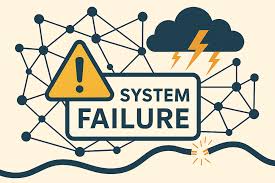
Failure often serves as the most powerful teacher in organizational learning—and the collapse of the FBI’s Virtual Case File (VCF) system is a prime example. Envisioned as a groundbreaking information technology (IT) upgrade to replace outdated case management tools, the VCF project aimed to deliver a modern, agile, and secure system. Yet, despite an investment of over $170 million, it failed to be fully implemented. This high-profile breakdown provides valuable lessons for Human Resource and IT management students seeking to lead digital transformation in complex, bureaucratic environments. What follows are four powerful lessons—balancing hopeful innovation with painful organizational truths.
At the heart of the VCF system’s failure wasn’t just the technology itself; it was a mix of mismanagement, scope creep, and a lack of alignment within the organization. The project suffered from an unclear and unstable vision, with frequent changes in requirements that were often poorly communicated (Office of the Inspector General, 2005). On top of that, the FBI’s limited technical know-how and inadequate vendor oversight led to slow progress and unmet objectives. These organizational shortcomings really underscore the need for agile project management and effective communication channels.
Students can explore project management and systems development challenges through real-world simulations at StudyCreek.com, gaining the critical skills necessary to avoid such costly failures.
There was a significant disconnect between the FBI’s Information Systems Strategy and the agency’s long-standing culture. While the strategy aimed for modernization and agility, the FBI’s bureaucratic and risk-averse environment wasn’t quite ready to embrace quick, flexible changes. For example, field agents were not used to integrated digital systems and still relied heavily on outdated methods. Conversely, points of alignment included a shared acknowledgment of the need for improved data management and national security tools.
This case demonstrates why strategic alignment is a vital concept covered in IT governance and HR leadership courses at DissertationHive.com, where students learn to match digital strategies with organizational readiness.

The CIO’s last remark about the need to shift attitudes—essentially transforming the agency’s approach to accepting and embracing technology—brings a mix of hope and doubt. While cultural change is achievable, it demands a strong commitment from the top, ongoing education, and effective change management strategies. If we don’t tackle the human aspect of innovation, even the best technical systems can fall short. Often, resistance to change stems from fear and inadequate training, rather than mere stubbornness.
If I were the CIO, I’d implement a phased strategy that emphasizes communication, training, and engaging stakeholders. Key steps would include:
First and foremost, I want to stress that technology isn’t just about building infrastructure—it’s fundamentally about people. By promoting digital literacy and getting users involved right from the start of the development process, we can pave the way for better adoption and long-term sustainability.

The FBI’s VCF failure serves as a cautionary tale and a valuable case study for both HR and IT students. It highlights how even the most powerful organizations can stumble when their culture, strategy, and execution are out of sync. If you’re looking to master successful digital transformations and navigate complex systems, check out the expert resources and support available at StudyCreek.com and DissertationHive.com.
Office of the Inspector General. (2005). The Federal Bureau of Investigation’s Management of the Trilogy Information Technology Modernization Project. U.S. Department of Justice. https://oig.justice.gov/reports/FBI/a0537/final.pdf
SAMPLE QUESTION
ANSWER
Title: Diagnosing the VCF System Failure: Strategic Lessons in IT Alignment and Change Management
Name:
Course: Human Resource Management
Instructor: [Instructor’s Name]
Date:
The FBI’s Virtual Case File (VCF) project was originally envisioned as a groundbreaking solution to revamp the agency’s outdated case management systems. Unfortunately, it ended up being a highly publicized flop, costing taxpayers over $170 million (Office of the Inspector General [OIG], 2005). For students of human resources and aspiring organizational leaders, examining the VCF failure offers crucial insights into strategic alignment, change management, and IT governance.

The downfall of the VCF system was rooted in a combination of technical, organizational, and managerial challenges. To start, the project suffered from an unstable and poorly defined scope. Requirements were constantly changing, and the software architecture was modified without a solid foundation, leading to ongoing delays (OIG, 2005). These ever-shifting expectations made it nearly impossible for developers to deliver a working system on schedule.
Additionally, there was a glaring lack of project management and oversight. The FBI didn’t adhere to industry-standard project management practices, which resulted in poor vendor coordination and quality control. Even when faced with warnings and performance issues, management kept approving more funding without tackling the underlying problems (Goldstein, 2005). On top of that, there was no phased implementation plan or pilot testing, which only heightened the risk of failure.
In the end, a lack of user engagement really added to the problem. The end users—primarily FBI agents and administrative staff—weren’t part of the design discussions. Because of this, the system didn’t align with their workflows, which resulted in a lot of frustration and usability challenges. These oversights highlight a significant gap between how technology is implemented and the actual behavior within the organization—something that’s vital to consider in HR and change management training.
While the VCF system’s strategic goals matched the FBI’s aim to improve data accessibility and bolster national security, there were significant misalignments between the information systems strategy and the agency’s culture. The FBI functioned within a strict, hierarchical framework where decision-making was centralized, and innovation wasn’t really part of the culture (Goldstein, 2005).
The IT strategy pushed for flexibility, real-time data sharing, and quick collaboration, yet the agency remained cautious and bureaucratic. This disconnect was clear in the pushback against new technologies and the hesitance to change existing processes. On the flip side, there was a shared understanding of the need for modernization, especially after 9/11. Both leadership and frontline agents recognized that the outdated systems were falling short of meeting the evolving demands of national security (OIG, 2005).
The CIO’s remark about the necessity of changing attitudes shows a deep understanding of what it takes to transform an organization. In theory, fostering a culture that embraces technology is crucial for achieving digital success. However, changing a culture is a long-term endeavor that demands structured interventions rather than just motivational speeches. Merely encouraging a shift in attitude without solid support systems—like training, incentives, and leadership examples—won’t lead to lasting behavioral change (Kotter, 1996).
So, while the CIO’s perspective is spot on, it’s unlikely to succeed without a well-rounded change management strategy. HR professionals need to understand that changing mindsets must be backed by systems, processes, and consistent messaging. Often, resistance to change stems from fear, uncertainty, and a lack of skills—issues that must be proactively tackled through organizational development initiatives.
If I were the Chief Information Officer (CIO) at the FBI, I would adopt a phased, inclusive, and HR-focused strategy to modernize the agency’s information systems:
Organizational Readiness Assessment: I would start with a thorough assessment of both cultural and technological readiness to pinpoint areas of resistance and identify capacity gaps.
Stakeholder Engagement: I’d make sure to involve end users right from the beginning. Establishing user groups and feedback loops would help ensure that the system design aligns with operational needs.
Phased Implementation: I would roll out smaller, manageable modules with ongoing feedback and testing. This method reduces risk and builds trust in the system.
Leadership Training: I’d provide training for leaders on digital transformation so they can exemplify the behaviors they want to see in their teams.
User Training and Support: I would create continuous training programs and offer strong technical support for users at all levels. This would help ensure that everyone feels confident and capable when using the new tools.
Performance Metrics and Incentives: Connect adoption metrics to performance reviews and provide rewards for departments that hit integration targets.
Continuous Communication: Establish open, two-way communication channels to keep staff updated and engaged throughout the modernization journey.
This HR-integrated approach ensures that modernization goes beyond just a technical upgrade; it’s a strategic transformation that focuses on people, processes, and purpose.
The VCF system failure serves as a stark reminder that successfully implementing technology isn’t just about having the right infrastructure or software. It’s about aligning strategic goals with organizational culture and employee behavior. For those studying human resource management, the VCF case study highlights the crucial role HR plays in driving change, fostering engagement, and creating an environment ripe for innovation. By putting people at the forefront alongside technology, future HR leaders can achieve the kind of digital transformation the FBI aimed for but ultimately fell short of.
Goldstein, H. (2005). Who killed the virtual case file? IEEE Spectrum, 42(9), 24–35. https://doi.org/10.1109/MSPEC.2005.1502523
Kotter, J. P. (1996). Leading change. Harvard Business Press.
Office of the Inspector General. (2005). The Federal Bureau of Investigation’s Management of the Trilogy Information Technology Modernization Project. U.S. Department of Justice.
https://oig.justice.gov/reports/FBI/a0537/final.pdf
Delivering a high-quality product at a reasonable price is not enough anymore.
That’s why we have developed 5 beneficial guarantees that will make your experience with our service enjoyable, easy, and safe.
You have to be 100% sure of the quality of your product to give a money-back guarantee. This describes us perfectly. Make sure that this guarantee is totally transparent.
Read moreEach paper is composed from scratch, according to your instructions. It is then checked by our plagiarism-detection software. There is no gap where plagiarism could squeeze in.
Read moreThanks to our free revisions, there is no way for you to be unsatisfied. We will work on your paper until you are completely happy with the result.
Read moreYour email is safe, as we store it according to international data protection rules. Your bank details are secure, as we use only reliable payment systems.
Read moreBy sending us your money, you buy the service we provide. Check out our terms and conditions if you prefer business talks to be laid out in official language.
Read more